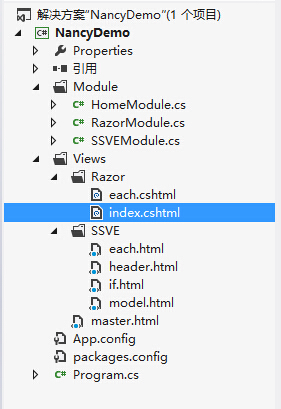前面一篇,讲解Nancy的基础,以及Nancy自宿主,现在开始学习视图引擎。
Nancy 目前支持两种 一个是SSVE 一个是Razor。下面我们一起学习。
The Super Simple View Engine
SSVE 全称就是 Super Simple View Engine ,翻译过来也就是 超级简单视图引擎。
我们在Nancy 不需单独引用,因为它是默认内置的。该引擎处理任何sshtml,html或htm文件。
模型可以是标准的类型,或ExpandoObject(或者实现 IDynamicMetaObjectProvider ,或者实现的IDictionary<string,object> 以访问其属性)。
SSVE是一个基于正则表达式的视图引擎,没有“执行代码”,所以你不能指定自己的代码来执行。内置的语法/命令,你可以使用如下所示。
Standard variable substitution
Replaces with the string representation of the parameter, or the model itself if a parameter is not specified. If the substitution can not be performed, for instance if you specify an invalid model property, it will be substituted with
[Err!]Syntax
@Model[.Parameters]Example
Hello @Model.Name, your age is @Model.User.AgeIterators
Enables you to iterate over models that are collection. Iterators cannot be nested
Syntax
@Each[.Parameters] [@Current[.Parameters]] @EndEach
@Eachwill implicitly be associated with the model and for each iteration the@Currentwill represent the current item in the collection.@Currentcan be used multiple times in the iterator block, and is accessed in the same way as@Model.Example
@Each.Users Hello @Current.Name! @EndEachConditionals
Parameters must be a boolean (see Implicit Conditionals below). Nesting of @If and @IfNot statements is not supported.
Syntax:
@If[Not].Parameters [contents] @EndIfExample
@IfNot.HasUsers No users found! @EndIfImplicit Conditionals
If the model has property that implements
ICollectionthen you can use an implicit conditional. The implicit conditional syntax is the same as a normal conditional, but theParameterspart can have aHas-prefix. The conditional will be true if the collection contains items, and false if it does not or if it is null.Syntax
Has[CollectionPropertyName]Example
@If.HasUsers Users found! @EndIfThe above example will expand to "Users found!" if the model has a collection called
Usersand it contains items; if the collection is empty then the text would not be displayed.HTML Encoding
Both the
@Modeland@Current keywords(with or without parameters) can have an optional!operator, after the@, to HTML encode the output.Syntax
@!Model[.Parameter] @!Current[.Parameter]Example
@!Model.Test @Each @!Current.Test @EndEachPartials
Renders a partial view. A property of the current model can be specified to be used as the partial view's model, or it may be omitted to use the current view's model instead. The file extension of the view is optional.
Syntax
@Partial['<view name>'[, Model.Property]]Example
// Renders the partial view with the same model as the parent @Partial['subview.sshtml']; // Renders the partial view using the User as the model @Partial['subview.sshtml', Model.User];Master pages and sections
You can put shared layout in a master page and declare content sections that will be populated by the views. It is possible to have nested master pages and you are not obligated to provide content for all of the content sections.
The master pages will have access to the
@Modelof the view and the file extension is optional when specifying the name of the master to use in your view.You can use the
@Sectiontag multiple times and is used to both declare a content section, in a master page, and to define the content blocks of a view.Syntax
@Master['<name>'] @Section['<name>'] @EndSectionExample
// master.sshtml <html> <body> @Section['Content']; </body> </html> // index.sshtml @Master['master.sshtml'] @Section['Content'] This is content on the index page @EndSectionAnti-forgery token
Renders an anti-forgery token, on the page, in an hidden input to prevent cross-site request forgery attacks. The token will automatically be validated when a new request is posted to the server (assuming CSRF protection hasn’t been turned off).
Syntax
@AntiForgeryTokenExample
@AntiForgeryTokenPath expansion
Expands a relative paths to a fully qualified URL.
Syntax
@Path['<relative-path>']Example
@Path['~/relative/url/image.png']Starting from v1.2, SSVE performs automatic path expansion in all HTML attributes (more specifically, in all
name="value"pairs, both with single and double quotes aroundvalue) where attribute value starts with~/. For example,<a href="@Path['~/relative/path']" ...>can be significantly shortened to<a href="~/relative/path" ...>.
下面来讲解一些常用的命令。
1.Model
2.Each
3.If
4.Partials
5.Master pages and sections
首先创建一个项目。建议创建web空项目 。
我是直接使用上次的项目 http://www.cnblogs.com/linezero/p/5121887.html
先创建一个Module SSVEModule
然后添加Views文件夹 -》然后再在其下添加 SSVE文件夹 -》添加对应的View 页。
这样使项目更加清楚。
1.Model
Get["/model"] = r => { var model = "我是字符串"; return View["model", model]; };
在SSVE 文件夹下添加一个model.html
<!DOCTYPE html> <html lang="en" xmlns="http://www.w3.org/1999/xhtml"> <head> <meta charset="utf-8" /> <title></title> </head> <body> @Model </body> </html>
然后我们访问页面 访问地址: http://localhost:9000/ssve/model

2.Each
Get["/each"] = r => { var arr = new int[] { 3, 6, 9, 12, 15, 12, 9, 6, 3 }; return View["each", arr]; };
each.html
<!DOCTYPE html> <html lang="en" xmlns="http://www.w3.org/1999/xhtml"> <head> <meta charset="utf-8" /> <title></title> </head> <body> @Each <p>@Current</p> @EndEach </body> </html>
访问地址: http://localhost:9000/ssve/each
3.If
Get["/if"] = r => { return View["if", new { HasModel = true }]; };
if.html
<!DOCTYPE html> <html lang="en" xmlns="http://www.w3.org/1999/xhtml"> <head> <meta charset="utf-8" /> <title></title> </head> <body> @If.HasModel <p>我出现了</p> @EndIf @IfNot.HasModel <p>我没办法出现</p> @EndIf </body> </html>
访问地址: http://localhost:9000/ssve/if
4.Partials
@Partial['header.html']
在SSVE 下添加header.html 然后在页面添加这句即可。
5.Master pages and sections
master.html
<!DOCTYPE html> <html lang="en" xmlns="http://www.w3.org/1999/xhtml"> <head> <meta charset="utf-8" /> <title></title> </head> <body> @Partial['header.html'] @Section['Content'] </body> </html>
使用 master
@Master['master.html'] @Section['Content'] <p>master partial content 结合</p> @Model @EndSection
SSVEModule.cs
using Nancy; using System; using System.Collections.Generic; using System.Linq; using System.Text; using System.Threading.Tasks; namespace NancyDemo { public class SSVEModule : NancyModule { public SSVEModule():base("/ssve") { Get["/"] = r => { var os = System.Environment.OSVersion; return "Hello SSVE<br/> System:" + os.VersionString; }; Get["/model"] = r => { var model = "我是字符串"; return View["model", model]; }; Get["/each"] = r => { var arr = new int[] { 3, 6, 9, 12, 15, 12, 9, 6, 3 }; return View["each", arr]; }; Get["/if"] = r => { return View["if", new { HasModel = true }]; }; } } }
SSVE视图引擎源码:https://github.com/grumpydev/SuperSimpleViewEngine
Razor View Engine
Razor 相信大家都是非常熟悉,所以也就不在这里过多做语法讲解。
主要是讲解在Nancy中使用Razor 视图引擎。
Nancy 的Razor 是自定义实现的,所以与ASP.NET MVC 中的Razor 有所不同。
在Nancy中绑定模型是@Model 不是ASP.NET MVC @model
安装
要在Nancy中使用Razor 需要安装 Nancy.ViewEngines.Razor
Nuget:Install-Package Nancy.Viewengines.Razor
添加Razor以后,会默认在app.config 添加Razor相关配置。
使用
建议大家新建一个空的web项目,这样便于编写视图。
在视图中声明 关键字为:@inherits
@inherits Nancy.ViewEngines.Razor.NancyRazorViewBase<dynamic>
其他语法与ASP.NET MVC Razor相同。
我还是在原项目上进行添加。
先创建一个Module RazorModule
然后添加Views文件夹 -》然后再在其下添加 Razor文件夹 -》添加对应的View 页。以 cshtml结尾的文件,也就是视图文件。
1.Model
Get["/index"] = r => { var model = "我是 Razor 引擎"; return View["index",model]; };
index.cshtml
@inherits Nancy.ViewEngines.Razor.NancyRazorViewBase<dynamic> <!DOCTYPE html> <html lang="en" xmlns="http://www.w3.org/1999/xhtml"> <head> <meta charset="utf-8" /> <title></title> </head> <body> @Model </body> </html>
访问地址: http://localhost:9000/razor/index
2.each
Get["/each"] = r => { var arr = new int[] { 3, 6, 9, 12, 15, 12, 9, 6, 3 }; return View["each", arr]; };
虽然Module中的代码与前面相同。但View 就不一样了。
each.cshtml
@inherits Nancy.ViewEngines.Razor.NancyRazorViewBase<dynamic> <!DOCTYPE html> <html lang="en" xmlns="http://www.w3.org/1999/xhtml"> <head> <meta charset="utf-8" /> <title></title> </head> <body> @foreach (var item in Model) { <p>@item</p> } </body> </html>
访问地址: http://localhost:9000/razor/each
RazorModule.cs
using System; using System.Collections.Generic; using System.Linq; using System.Text; using System.Threading.Tasks; using Nancy; namespace NancyDemo { public class RazorModule:NancyModule { public RazorModule() :base("/razor") { Get["/"] = r => { var os = System.Environment.OSVersion; return "Hello Razor<br/> System:" + os.VersionString; }; Get["/index"] = r => { var model = "我是 Razor 引擎"; return View["index",model]; }; Get["/each"] = r => { var arr = new int[] { 3, 6, 9, 12, 15, 12, 9, 6, 3 }; return View["each", arr]; }; } } }
项目结构

因为我使用的项目是控制台程序,Views 文件夹下的文件必须都要在 属性 选择 始终复制 。
在linux上运行可以参考上篇文章。
最后留个坑,下一篇:Nancy 学习-进阶部分 继续跨平台。请大家多多支持。
参考链接:
https://github.com/NancyFx/Nancy/wiki/The-Super-Simple-View-Engine
如果你觉得本文对你有帮助,请点击“推荐”,谢谢。